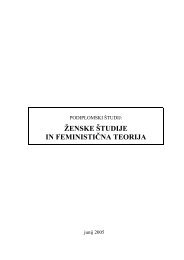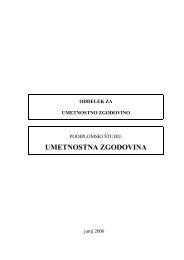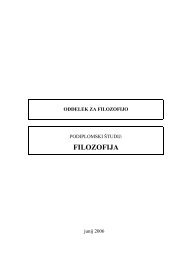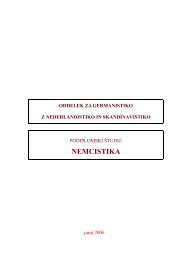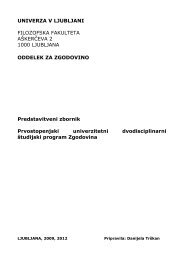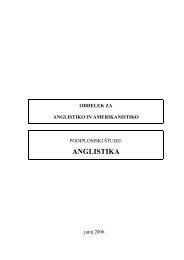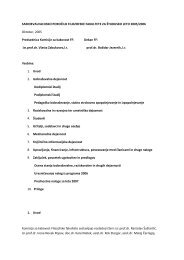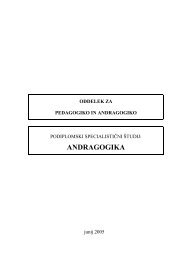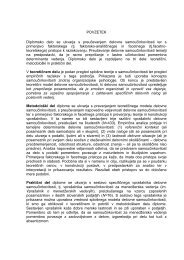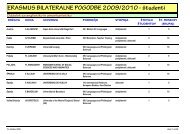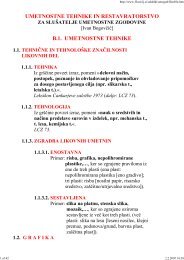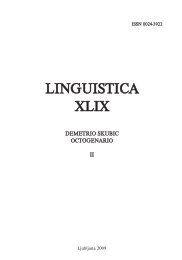B_solo_zgibanke male new_1 - Filozofska fakulteta
B_solo_zgibanke male new_1 - Filozofska fakulteta
B_solo_zgibanke male new_1 - Filozofska fakulteta
Create successful ePaper yourself
Turn your PDF publications into a flip-book with our unique Google optimized e-Paper software.
would result in correct predictions only if parallel alignment were utilized, a move<br />
that is not permitted in this case. the situation supports my old assumption that<br />
syntactic similarity should be given preference when the choice is between syntactic<br />
and semantic similarity. For instance, the construction (as well as the grammatical<br />
number) of the type petit enfant and of the type enfant aimable is alike semantically,<br />
whereas the type enfant aimable and the type enfants adorables are similar<br />
syntactically (and semantically less similar; note the difference in grammatical<br />
number). Consequently the deduction involving the variants enfant aimable and<br />
enfants adorables, displaying considerable syntactic similarity, is successful (above),<br />
whereas the deduction involving the variants petit enfant and enfant aimable, whose<br />
syntactic similarity is smaller, would not succeed.<br />
4.2. in the plural of compound words such as arcs-en-ciel ‘rainbows’ the head ends in<br />
a plural with orthographic -s; unexpectedly, there is no accompanying liaison in the<br />
pronunciation. the reason: the ending was added by prescriptive grammarians and<br />
was never pronounced (Grevisse 1993: 808).<br />
(9) French, only the soigné variety. Liaison is absent (in complex verb phrases)<br />
before a non-finite verb if the inversion of the subject and the finite verb is realized;<br />
for instance, sont^-ils|entrés ‘did they enter’. if inversion is lacking, liaison is<br />
optional; for instance, je vais(^)aller ‘i will go’ (Léon 1966: 124, 129).<br />
the two variants: (non-)realized inversion of the subject and the finite verb. –<br />
the deduction proceeds in the unnatural environment “complex verb phrase”.<br />
See item 4.1.<br />
1. the assumptions of Natural Syntax:<br />
1.1. >nat (+,–) / left movement of the finite verb<br />
i.e., left movement is more natural than non-movement. – the inversion of the<br />
subject and the finite verb consists in the left movement of the finite verb across the<br />
subject. according to the process criterion, item (f) in the list of axioms.<br />
1.2. >nat (+,–) / liaison<br />
i.e., realized liaison is more natural than unrealized liaison. – the absence of<br />
liaison is in the interest of the hearer because it is easier for him to identify words<br />
lacking liaison. according to the principle of favourable for the hearer, item (a) in<br />
the list of axioms.<br />
a special case of 1.2:<br />
1.2.1. >nat (+/–,–) / liaison<br />
the scale assumes the permitted expanded format >nat (a + B, B) and is<br />
automatically valid because the corresponding basic scale 1.2 has been substantiated.<br />
2. the rules of chiastic alignment:<br />
2.1. value a tends to associate with value D,<br />
2.2. value B tends to associate with value C.<br />
3. the consequences:<br />
if a language distinguishes between the inversion of the subject and the finite<br />
verb and the absence of such inversion such that one alternative allows optional<br />
44



